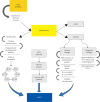Sex Hormones and Inflammation Role in Oral Cancer Progression: A Molecular and Biological Point of View
- PMID: 32684934
- PMCID: PMC7336237
- DOI: 10.1155/2020/9587971
Sex Hormones and Inflammation Role in Oral Cancer Progression: A Molecular and Biological Point of View
Abstract
Oral cancers have been proven to arise from precursors lesions and to be related to risk behaviour such as alcohol consumption and smoke. However, the present paper focuses on the role of chronic inflammation, related to chronical oral infections and/or altered immune responses occurring during dysimmune and autoimmune diseases, in the oral cancerogenesis. Particularly, oral candidiasis and periodontal diseases introduce a vicious circle of nonhealing and perpetuation of the inflammatory processes, thus leading toward cancer occurrence via local and systemic inflammatory modulators and via genetic and epigenetic factors.
Copyright © 2020 Maria Contaldo et al.
Conflict of interest statement
The authors declare that they have no conflicts of interest.
Figures


References
-
- Lauritano D., Lucchese A., Contaldo M., et al. Oral squamous cell carcinoma: diagnostic markers and prognostic indicators. Journal of Biological Regulator and Homeostatic Agents. 2016;30(2):169–176. - PubMed
-
- Santoro A., Laino L., Contaldo M., et al. Adenocarcinoma NOS of the maxillary sinus: clinical and histopathological features with therapeutic considerations. Otolaryngology. 2011;1(1):2–4. doi: 10.4172/2161-119x.1000103. - DOI
-
- Santoro A., Pannone G., Contaldo M., et al. A troubling diagnosis of verrucous squamous cell carcinoma (“the bad kind” of keratosis) and the need of clinical and pathological correlations: a review of the literature with a case report. Journal of Skin Cancer. 2011;2011:4. doi: 10.1155/2011/370605.370605 - DOI - PMC - PubMed
Publication types
LinkOut - more resources
Full Text Sources

